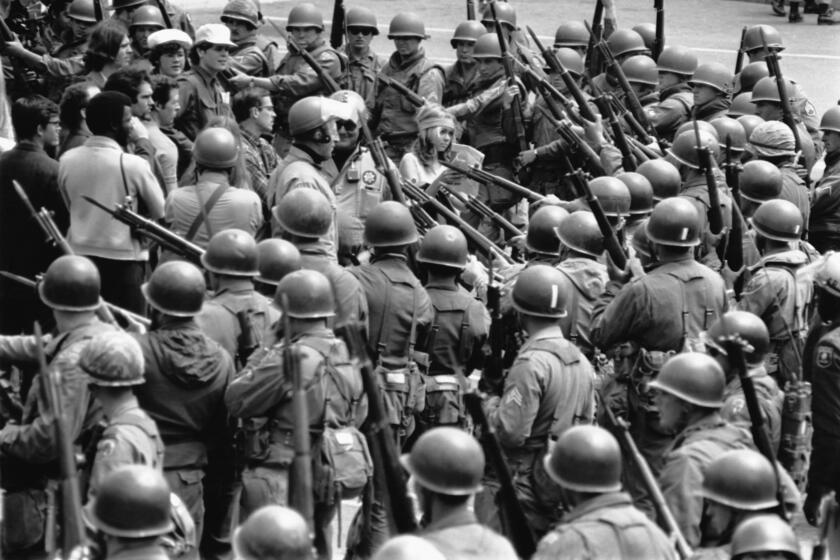California’s Blue-Collar Blues
Few Californians seem aware of the state’s disturbing economic circumstances. The economy is losing well-paying blue-collar and middle-class jobs at an astounding rate, especially in the Bay Area. Meanwhile, growth is increasingly concentrated in a handful of outlying counties. As a result, California’s economy is fragmenting as never before between slow-growth, politically powerful population centers and pro-growth, politically marginal counties that surround urban cores. And California’s leaders seem indifferent.
Since January 2001, the state has officially lost a net of about 82,000 jobs, far fewer than in the country as a whole. But this apparent good fortune is misleading. California’s employment picture has been worsening over the last few months, while the jobless rate nationwide has stabilized. California’s manufacturing economy, a key employment resource for the state’s immigrant and working-class populations, has shed nearly 170,000 positions since January 2001, a staggering 10% of the industrial workforce. Bedrock middle-class business services and the motion-picture industry are down nearly 130,000 jobs in the same period.
The state’s only employment bright spots are government, which is adding jobs at nearly twice the national pace, and low-paying retail. But neither of these sectors creates wealth. Record levels of deficit spending, mortgage refinancing and short-term credit incentives are artificially stimulating these sectors.
To an unprecedented extent, most of California’s economic pain is concentrated in its heavily populated urban core areas. Since the start of 2001, the San Francisco and San Jose metro regions have lost nearly 150,000 jobs, about 7% of the total regional workforce. That’s a faster decline than even badly wounded Southern California suffered from the defense and aerospace cutbacks in the dark days of 1990-92.
After several years of solid if unspectacular expansion, Los Angeles County, home to about 25% of the state’s employment, has lost about 55,000 jobs. All told, more than 200,000 jobs have vanished from the San Francisco and Los Angeles metro areas since 2001, nearly two-thirds of the state’s total employment loss in the first 20 months of the 1990s recession. Unlike the early 1990s, the urban meltdown is frighteningly universal in scope and includes reductions in service, film production, manufacturing, high-tech, finance, wholesale trade and construction employment.
These realities, however, are partly obscured by the remarkable vitality of the state’s more conservative outlying areas, particularly the southern counties surrounding Los Angeles. Growth-oriented Riverside, San Bernardino, Orange and northern San Diego counties have generated more than 90,000 new jobs in the teeth of the national slowdown, offsetting about half of the decline in employment in the San Francisco, San Jose and Los Angeles metro regions. In marked contrast with Los Angeles and the Bay Area, manufacturing-job losses have been minimal in these counties. Healthy gains have been achieved in the construction, business services, communications, trade, finance, engineering and management sectors. Many parts of the Central Valley and other eastern areas of the state are also expanding, albeit less rapidly.
Still, California’s manufacturing meltdown is especially troubling because goods production is crucial to the state’s social and technological advancement. Manufacturing disproportionately employs people who lack college degrees, like first-generation immigrants, and pays better wages and benefits than nonmanufacturing jobs. Deprived of quality jobs, working- and middle-class California families will be unable to improve their lot. Inequality, already a severe problem, will almost certainly become worse.
The apparent failure of California’s leaders to grasp such peril is directly related to the state’s urban anti-growth politics. To be sure, the stock market bubble of the late 1990s breathed life into the Bay Area and Los Angeles regions, creating, at least for a time, the illusion that they had found a way to grow without a full-spectrum economy. Even now, many fantasize that good times are just around the corner. But California’s biggest population centers have long been economic laggards.
Twenty years ago, the San Francisco and San Jose metro areas generated about 16% of California’s total employment. Today, they account for less than 14%. Over the same period, unheralded Orange, San Bernardino and Riverside counties grew much more rapidly and by 2002 accounted for 25% more jobs than their slower-growing northern counterparts. The western Bay Area and the Los Angeles regions accounted for more than half of California’s job base in the early 1980s; their share has since fallen to 40%.
This development reflects an urban political consensus that disfavors all but elite, white-collar job growth, a strategy that has boosted land prices to comparatively high levels, led to unpredictable, complex regulation and limited working- and middle-class business development. As these attitudes became entrenched in Greater San Francisco and Los Angeles, economic activity moved to the state’s more conservative, pro-growth counties inland. Quite possibly the most damaging fantasy spawned by the bubble economy is the belief that California’s cities had somehow jump-started their economies without changing their policies. But since the mind-numbing “new economy” hype ended, the state’s split into slow- and faster-growth regions has become more apparent than ever.
This has created something of a political paradox. The state’s overwhelmingly Democratic leaders, firmly anchored in large urban areas, seek to boost the scope and size of government, which requires a vibrant economy and ever-expanding tax revenues. During the last boom, they gambled that a handful of stock-option multimillionaires would finance public budgets indefinitely. That didn’t happen, so today they must rely on the state’s most conservative, rapidly growing regions for funding. It’s difficult to imagine that a leadership drawn from California’s most anti-growth population centers can possibly coexist with, let alone sustain, the politically hostile pro-growth periphery they must increasingly tax to fund their agendas.
In the past, efforts to develop an urban growth policy usually degenerated into bitter, inconclusive battles over the scope and reach of regulation. In reality, the most urgent need is not the removal of regulatory controls but assuring that controls are predictably and uniformly applied. What most cripples urban development is the possibility that any interest group or bureaucrat can manipulate the regulatory process to upset business planning. The state should eliminate the chronic capriciousness in land use, tax, labor, environmental and similar laws that have restrained its urban economy. At present, Californians are preparing to vote in an atmosphere of economic delusion. After the election, when the state’s new leaders can safely claim their seats, they will almost certainly discover that such neglect has a high price.






